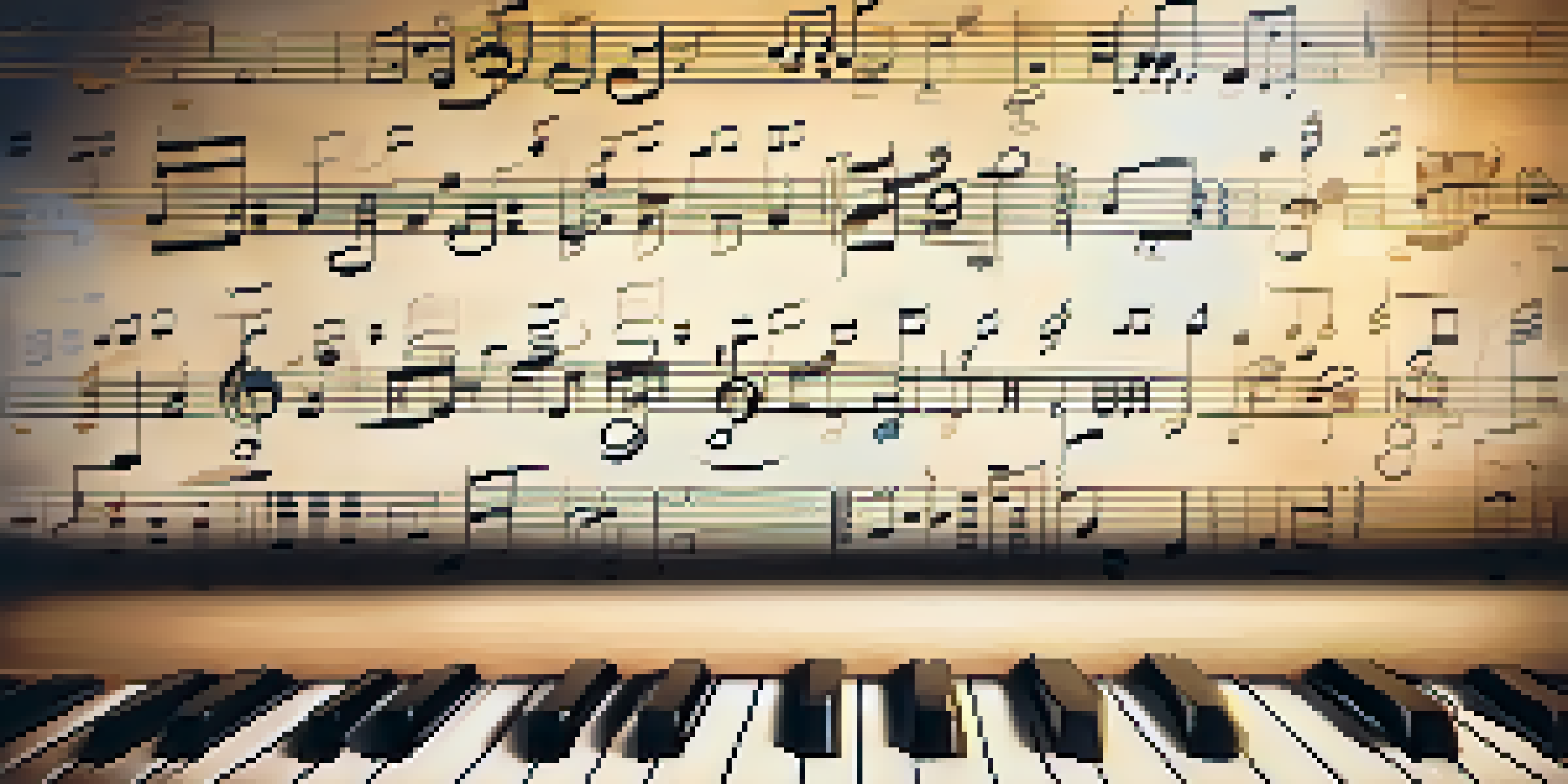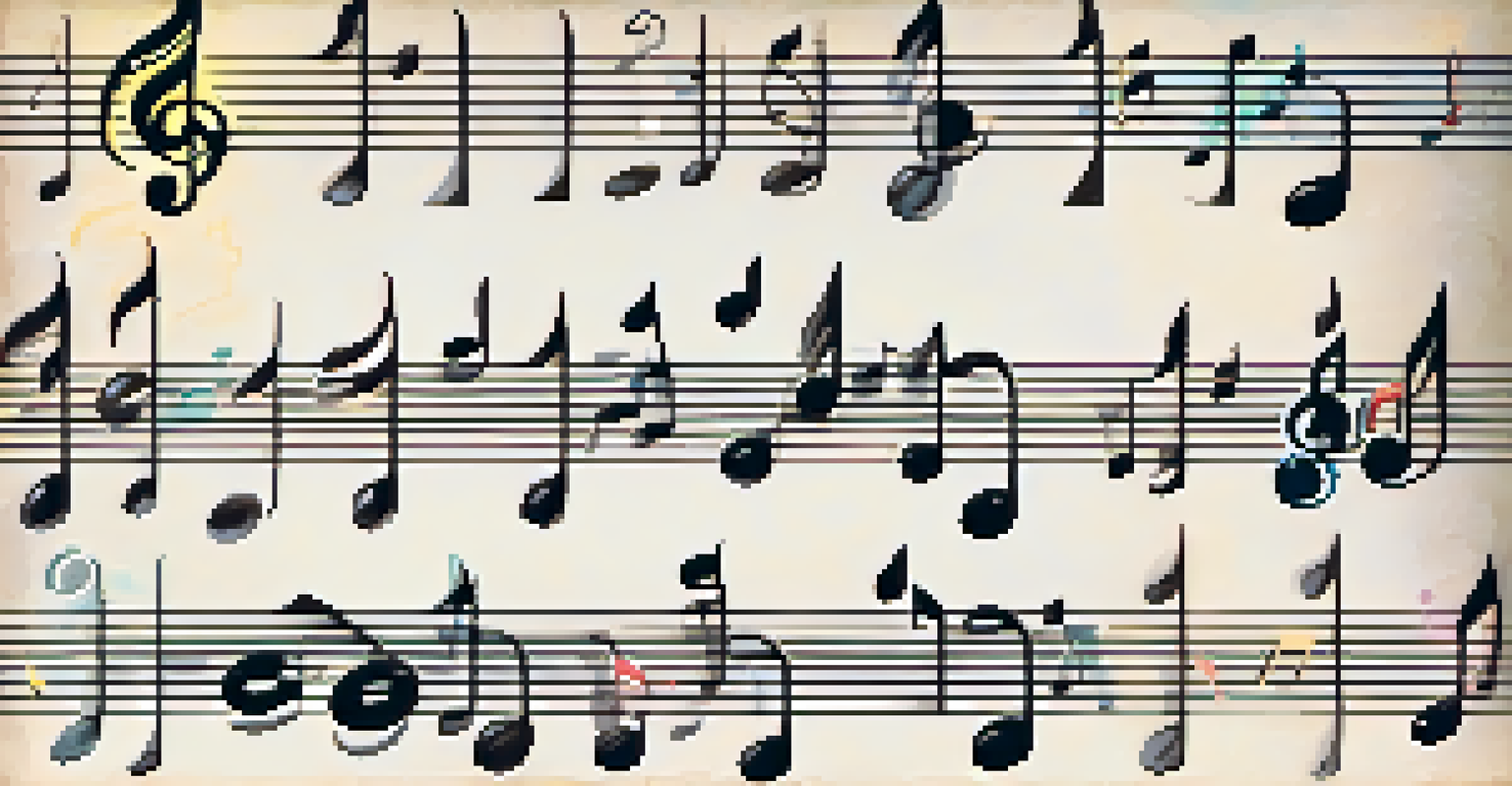How to Read Sheet Music: A Beginner’s Comprehensive Guide

Understanding the Basics of Sheet Music
Reading sheet music might seem daunting at first, but it's really about understanding a new language. Just like learning to read a book, sheet music has its own set of symbols and rules that communicate musical ideas. With a little practice, anyone can start to decipher these notes and rhythms.
Music is the shorthand of emotion.
At its core, sheet music consists of staff lines, notes, and various symbols that indicate pitch, duration, and dynamics. The staff is made up of five lines and four spaces, where each line and space represents a different musical note. Familiarizing yourself with these basics creates a solid foundation for your musical journey.
Think of sheet music as a roadmap for musicians; it guides you through a piece just as a map guides you through a city. The more you explore, the more comfortable you'll become navigating its complexities.
Notes and Their Positions on the Staff
The first step in reading sheet music is to learn about notes and their positions on the staff. Each note is placed on either a line or a space, and the position indicates its pitch. For example, the note on the bottom line of the treble clef staff is an E, while the note in the first space is an F.

There are different types of notes, such as whole notes, half notes, and quarter notes, which represent different durations of sound. Understanding the difference between these notes is crucial, as it affects how you play the music. You wouldn't want to rush a whole note or hold a quarter note too long!
Basics of Reading Sheet Music
Learning to read sheet music is like understanding a new language, with symbols and rules that convey musical ideas.
A great way to memorize note positions is to use mnemonic devices. For example, the notes on the lines of the treble clef can be remembered with the phrase 'Every Good Boy Deserves Fudge.' With some practice, you'll have these notes down in no time!
Understanding Clefs: Treble and Bass
Clefs are essential elements in sheet music that determine which notes correspond to the lines and spaces of the staff. The two most common clefs are the treble clef, which is used for higher-pitched instruments, and the bass clef, which is for lower pitches. Familiarizing yourself with these clefs is crucial for any aspiring musician.
The only truth is music.
The treble clef, often seen at the beginning of piano music, indicates that the notes are higher in pitch. It curls around the second line of the staff, which represents the note G. On the other hand, the bass clef is used for notes that are lower in pitch, and it dots the fourth line, representing F.
By understanding both clefs, you can read music for various instruments, from flutes and violins to cellos and bass guitars. It's like learning two different dialects in the same language!
Rhythms and Note Durations Explained
Rhythm is the heartbeat of music, and understanding it is key to playing any piece. In sheet music, rhythm is represented by different types of notes and rests, which indicate how long to play or pause. Recognizing these symbols and their meanings is essential for playing music accurately.
For instance, a whole note is held for four beats, while a half note lasts for two beats. Meanwhile, a quarter note is just one beat, and rests indicate silence in the music. If you've ever clapped along to a song, you've already tapped into the concept of rhythm, which makes this part easier to grasp.
Understanding Clefs and Notes
Clefs define the pitch of notes on the staff, with treble for higher sounds and bass for lower ones.
Practicing clapping out different rhythms can help solidify your understanding of note durations. Think of rhythm as the dance of music; it brings life to the notes and transforms a simple melody into a captivating performance.
Learning Musical Key Signatures
Key signatures are another important aspect of reading sheet music, as they indicate the key of the piece and which notes are sharp or flat. These signatures appear at the beginning of the staff and remain consistent throughout the piece, guiding you on which notes to modify. Understanding key signatures helps musicians play in harmony with others.
For example, if you see one sharp in the key signature, it indicates that F is sharp throughout the piece. Conversely, a key signature with flats tells you which notes to lower. It's like having a cheat sheet to help you navigate the music!
To familiarize yourself with key signatures, try creating flashcards for each one. This method makes it easier to visualize and recall them when you encounter them in sheet music.
Dynamics: The Art of Expression in Music
Dynamics refer to the volume of music, and they play a crucial role in conveying emotions. In sheet music, dynamics are indicated with symbols such as 'p' for piano (soft) and 'f' for forte (loud). By understanding dynamics, you can add depth and expression to your playing, transforming a simple melody into a moving performance.
Imagine telling a story through music; just as your voice might rise and fall with emotion, so should the volume of your playing. Dynamics help to create tension, excitement, and resolution, engaging listeners on a deeper level.
Importance of Rhythm and Dynamics
Rhythm provides the heartbeat of music while dynamics add emotional depth, making performances captivating.
To practice dynamics, try playing a piece softly and gradually increasing the volume to a loud crescendo. This exercise not only enhances your performance but also strengthens your understanding of how dynamics influence the overall feel of a piece.
Tips for Practicing and Improving Your Skills
As with any skill, practice is essential for mastering sheet music. Set aside regular practice time and focus on gradually building your abilities. Start with simple pieces to gain confidence before moving on to more complex compositions. Consistency is key, so make practice a part of your daily routine.
Utilizing resources like online tutorials, apps, or even sheet music books can greatly enhance your learning experience. Many of these tools provide interactive ways to engage with the material, making practice more enjoyable. It's like having a personal coach cheering you on from the sidelines!

Lastly, don’t be afraid to make mistakes—it's all part of the learning process. Each error is an opportunity to grow, so embrace them and keep pushing forward. With time and dedication, you'll find yourself reading sheet music with ease and confidence.